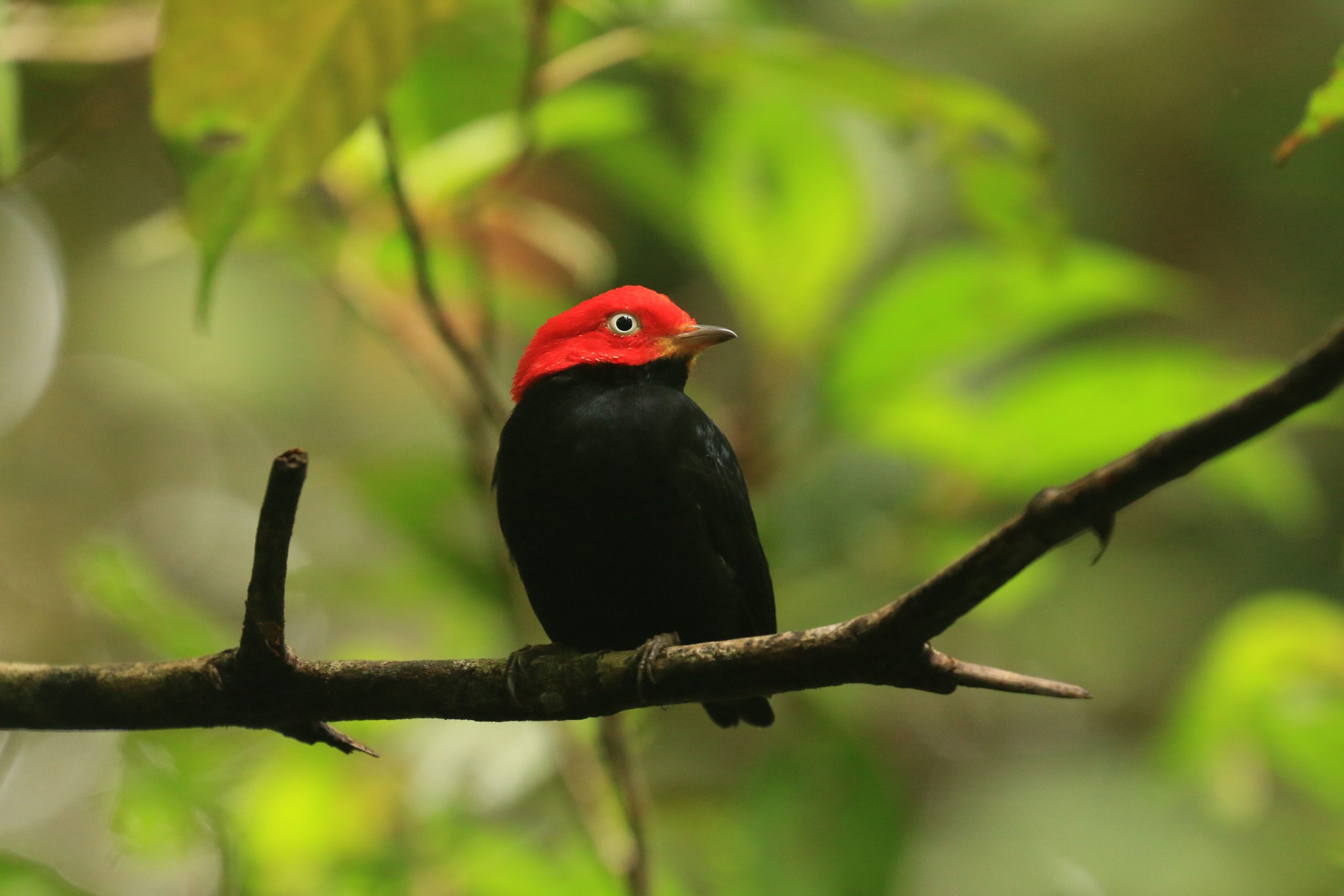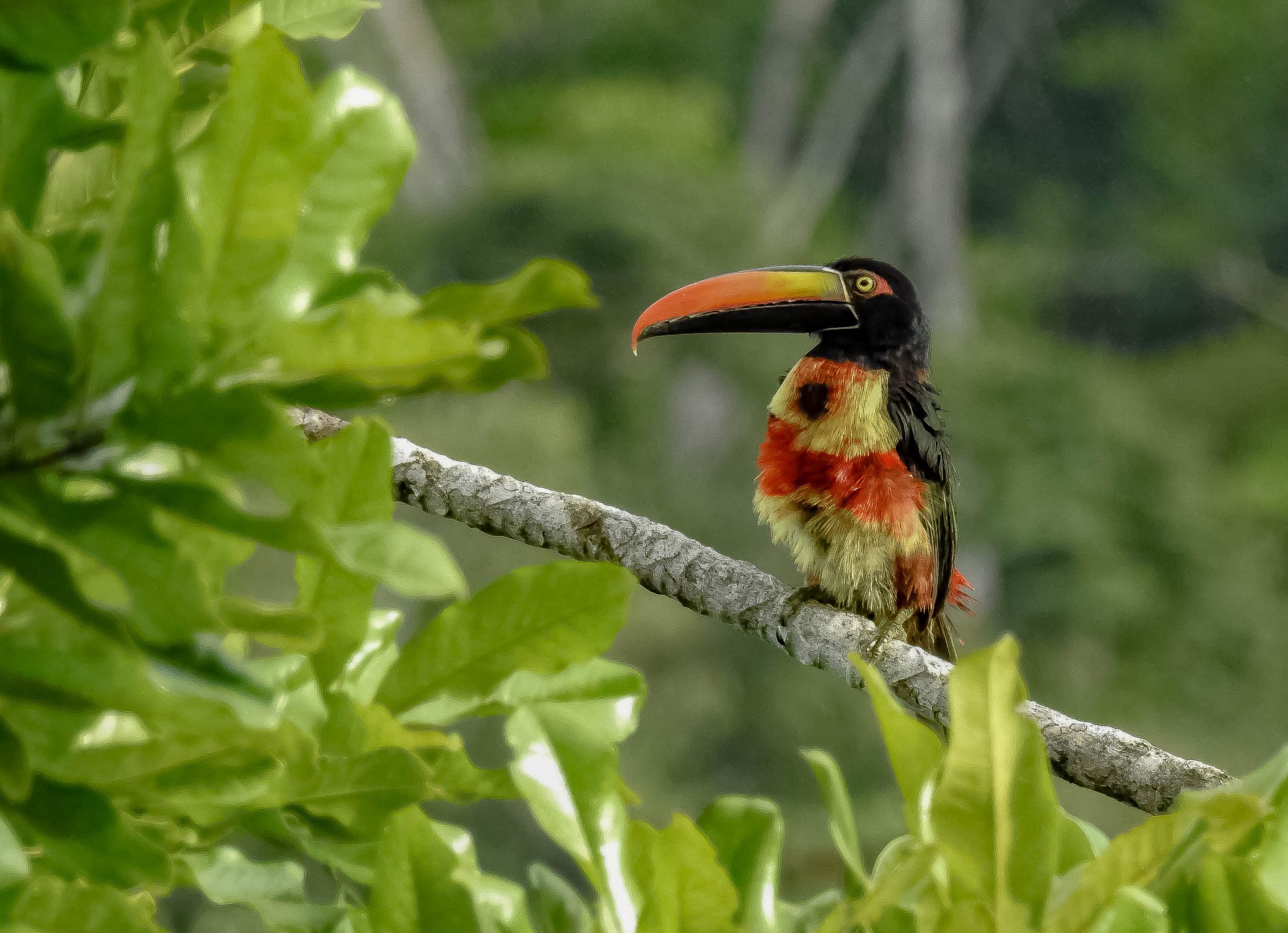
Perched on an open Cecropia branch and drenched in the late afternoon sun, the Fiery-billed Aracari lights up like a semaphore showing off its rich yellows, reds and tangerine orange hues!
Fiery-billed Aracari | (Pteroglossus frantzii) | Family: Ramphastidae (Toucans)
Costa Rican Year-Round Resident
Fiery-billed Aracari (Pteroglossus frantzii): Frank Lambert, XC411100. Accessible at www.xeno-canto.org/411100.
Español Abajo…………..
The Fiery-billed Aracari is a medium sized toucan and arguably one of the most colorful and ostentatious species of the bird world. It shines brightly with its yellow breast, red belly band, black spot on the breast, and its orange and yellow maxilla. The male and female are morphologically the same. This aracari will make its presence known by its loud, piercing “tis-sik” call as it roams around in large groups moving from tree to tree one after the other as if in single file formation. While they spend most of their time higher up in the forest canopy, they will come down to open areas to feed on fruiting trees, the cecropia tree being an early morning and late afternoon favorite.
The name aracari originates from Arassari, the name used by the aboriginal Tupi people of Brazil dating back as early as the 16th century. The genus Pteroglossus was introduced in 1811 which combines the Ancient Greek pteron meaning “feather” with glōssa meaning “tongue”.
There are 42 species of toucans native to tropical America, and they are known for their disproportionately huge bills. The Fiery-billed Aracari is one of two aracari species found in Costa Rica, the other being the Collared Aracari. The Fiery-billed is regionally endemic to the southern pacific region of Costa Rica and the northern pacific region of Panama. That’s it! Its range is fairly restricted and it is in good company with several other regional endemics found in Osa. The Collared Aracari on the other hand has a much larger distribution from Mexico down into the northern sections of South America. While both species are considered of Least Concern (LC) by the International Union for the Conservation of Nature (IUCN), the Fiery-billed Aracari is now under a more watchful eye due to range reduction in Panama.
Mostly frugivorous, this species also feeds on insects (especially during the breeding period), reptiles, eggs, and small nestlings of other species. Thanks to its long bill, it can reach for fruit located on flimsy branches that would not support its body weight. Their long bill also helps them to reach into elongated pensile structure nests to reach for nest contents. They are known to eject other cavity nesting birds, mainly woodpeckers, from their nest and take it as their own. Both sexes incubate and care for young, a trait common in toucan species.
Aracaris are the only toucans to roost in the same cavity as a family (adults and young alike) throughout the year. To allow this to happen, toucans have an amazing trait; three rear tail vertebrae are fused and attached to the spine by a ball and socket joint which enables it to flip its tail back up over its head. While it’s rooting in the cavity, it rests its head on its back with its tail flipped up making it look like a big inverted feathery ball.
Mythology and Lore
The curious bill of the toucans was thought to be magical to the indigenous people of central and south America. The ancient Aztecs believed the toucans bill was created from rainbows; their reward for being messengers of the Gods. The Aztecs would perform rituals using toucan feathers so that the gods would grant them rain. The toucan also shows up in Amazonian lore as a symbol of abundance and fertility. Its large bill was seen as a sign of good luck and prosperity. Medicine men would summon the toucan from the spirit world to cure victims of witchcraft. The Quichua people didn’t look at the bill so favorably, seeing it as an instrument of black magic believing it to inflict disease and carry the arrows of sorcerers.
Español
El Tucancillo Piquianaranjado (Cusingo) es un tucán de tamaño mediano y posiblemente una de las especies más coloridas y ostentosas en el mundo. Brilla intensamente con su pecho amarillo, su banda abdominal roja, su mancha negra en el pecho y su maxilar anaranjado y amarillo. El macho y la hembra son morfológicamente iguales. Este aracari dará a conocer su presencia por su fuerte y penetrante llamado “tis-sik” mientras andan en grandes grupos moviéndose de árbol a árbol, uno tras otro, como si formara una sola fila. Si bien pasan la mayor parte del tiempo en las zonas más altas de la copa del bosque, bajan a áreas abiertas para alimentarse de árboles frutales, siendo el árbol de Cecropia peltata uno de los favoritos temprano en la mañana y en la tardecer.
El nombre aracari proviene de Arassari, el nombre utilizado por los aborígenes tupí de Brasil que se remonta al siglo XVI. El género Pteroglossus se introdujo en 1811 y combina el griego antiguo ptero que significa “pluma” con glōssa que significa “lengua”.
Hay 42 especies de tucanes nativas de América tropical y son conocidos por sus picos desproporcionadamente grandes. El Cusingo es una de las dos especies de aracari que se encuentran en Costa Rica, la otra es el Aracari de collar. El pico de fuego es endémico regionalmente en la región del Pacífico sur de Costa Rica y la región del Pacífico norte de Panamá. ¡Eso es todo! Su área de distribución es bastante restringida y está en buena compañía con otras especies endémicas regionales que se encuentran en Osa. El Tucancillo Collarejo, por otro lado, tiene una distribución mucho mayor desde México hasta las secciones del norte de América del Sur. Si bien ambas especies son consideradas de Preocupación Menor (LC) por la Unión Internacional para la Conservación de la Naturaleza (UICN), el Tucancillo Piquianaranjado está ahora bajo mayor vigilancia debido a la disminución de hábitat en Panamá.
Principalmente frugívora, esta especie también se alimenta de insectos (especialmente durante el período de reproducción), reptiles, huevos y pequeños polluelos de otras especies. Gracias a su largo pico, puede alcanzar frutos ubicados en ramas endebles que no soportarían su peso corporal. Su largo pico también les ayuda a alcanzar los nidos con estructuras pensiles alargadas para alcanzar su contenido. Se sabe que expulsan de su nido a otras aves que anidan en cavidades, principalmente pájaros carpinteros, y lo toman como propio. Ambos sexos incuban y cuidan a las crías, un rasgo común en las especies de tucanes.
Los aracaris son los únicos tucanes que se posan en la misma cavidad como familia (tanto adultos como jóvenes) durante todo el año. Para permitir que esto suceda, los tucanes tienen una característica sorprendente; Las tres vértebras traseras de la cola están fusionadas y unidas a la columna mediante una articulación esférica que le permite voltear la cola hacia arriba sobre su cabeza. Mientras enraiza en la cavidad, apoya la cabeza sobre su espalda con la cola levantada, lo que la hace parecer una gran bola de plumas invertida.
Mitología y Leyenda
Los pueblos indígenas de América Central y del Sur pensaban que el curioso pico de los tucanes era mágico. Los antiguos aztecas creían que el pico de los tucanes se creaba a partir del arco iris; su recompensa por ser mensajeros de los Dioses. Los aztecas realizaban rituales utilizando plumas de tucán para que los dioses les concedieran lluvia. El tucán también aparece en la tradición amazónica como símbolo de abundancia y fertilidad. Su gran pico era visto como un signo de buena suerte y prosperidad. Los curanderos convocaban al tucán del mundo de los espíritus para curar a las víctimas de la brujería. El pueblo quichua no veía tan favorablemente el pico, viéndolo como un instrumento de magia negra, creyendo que infligía enfermedades y portaba las flechas de los hechiceros.
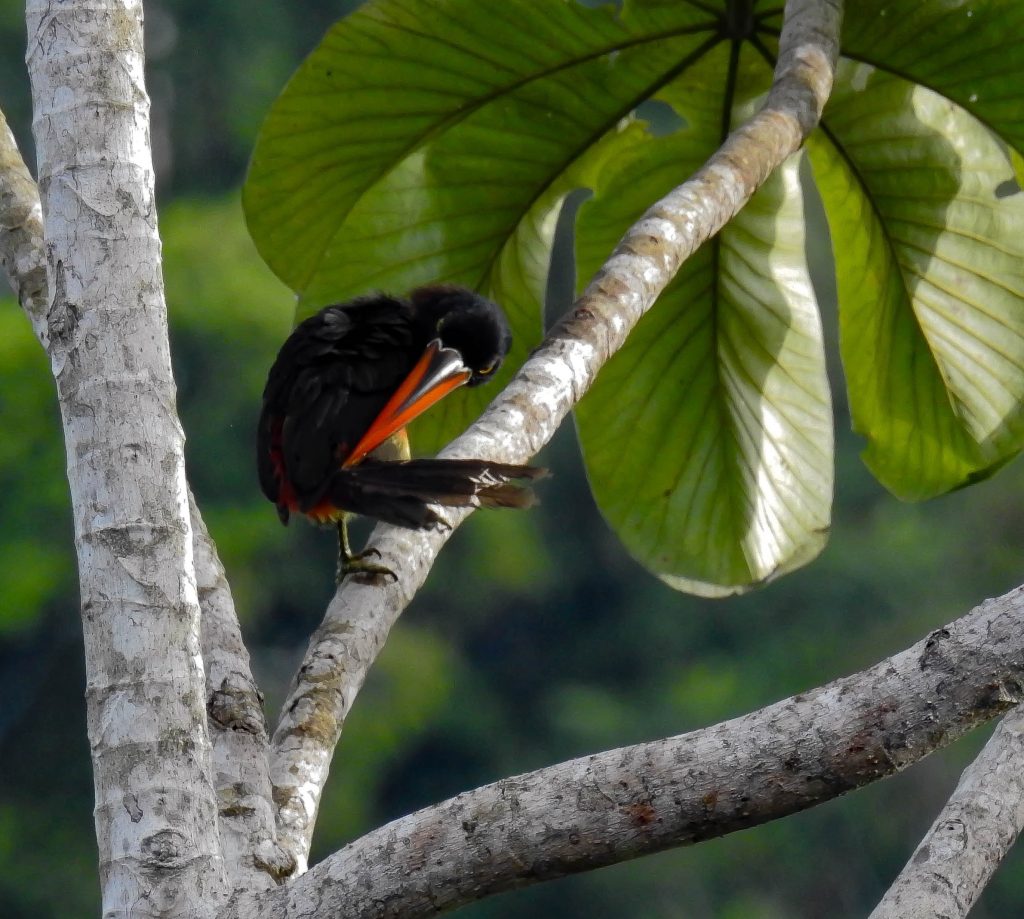
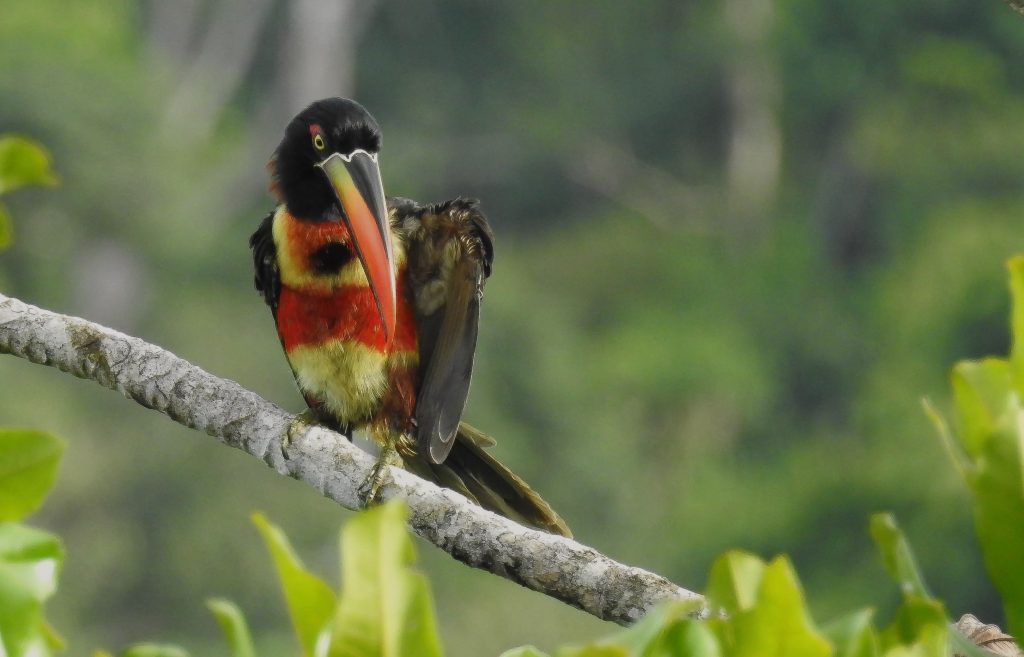
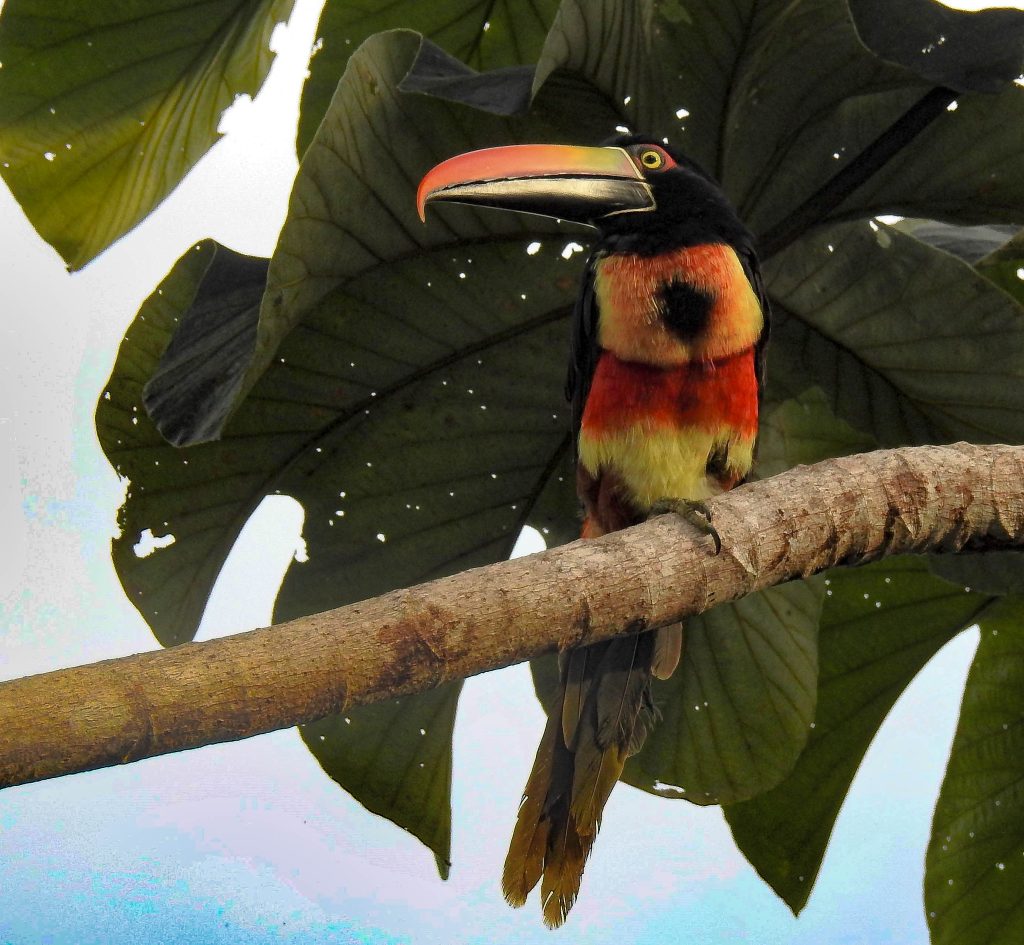
Follow Us!


